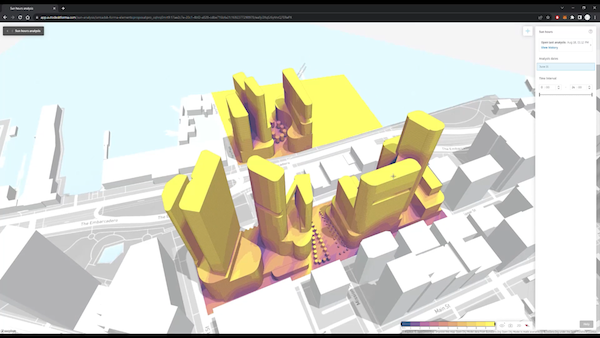
When Zutari Ltd., a South African engineering consultancy, committed to a digital transformation of its key processes, company leaders knew widespread changes and training would be needed. Manual processes would be replaced with more automated, digital solutions. 2D, paper-based drawings would largely be replaced with digital 3D models. Staff training would be key to implementing these new practices and improving efficiency.
As with many AEC firms across the globe, Zutari’s digital transformation is a work in progress, but the company is making big strides in moving to more digital workflows. Employees are embracing the changes and using new training tools to learn key software skills and apply the knowledge on projects.
“Everything we do is based on the capability and competency of our staff,” said Selvan Murugan, digital practice leader at Zutari. To provide more flexible software training, the company adopted a new e-learning platform in 2021 that is starting to bear fruit. While difficult to quantify, Murugan shared that, “Our overall efficiency has definitely improved.”

Selvan Murugan, Zutari Ltd., digital practice leader.
New Ways of Working
Zutari’s digital transformation is aimed at adopting new technology to perform work that has historically required tedious, repetitive tasks, whether on paper or on computers. “We actively look for [how] to change old ways of working to new ways of working,” said Murugan.
As an example, he cites the use of 3D modeling at the outset of projects, rather than traditional data collection and generation of multiple views via paper drawings. “We used to have drafters at computers producing reams of drawings. All of that has changed. We have a model-first approach now,” said Murugan, noting greater use of drones and 3D scanning for data collection and building information modeling (BIM) for design.
To aid adoption of the new processes, Zutari has taken a proactive training approach, based primarily on Eagle Point Software’s Pinnacle Series, an e-learning platform with courses geared for Autodesk, Bentley, and Esri products, among others. Zutari rolled out the training in phases. It first conducted a pilot program to assess the courseware. After selecting Pinnacle, the company then focused on training technical directors, learning managers, and project champions. Once management was up-to-date, Zutari then trained production staff.
Zutari has configured its Pinnacle Series courseware so staff can take courses independently or as directed by managers. The firm also uses the KnowledgeSmart online testing platform, integrated with the Pinnacle Series, to assess knowledge levels of prospective employees. “It’s like a test [administered by human resources staff],” said Murugan.

Zutari has customized Eagle Point’s training products to include company logos and other information. Image source: Eagle Point Software.
Morphing from Design Software to Training Software
Eagle Point’s training products are rooted in a company once known for developing its own engineering design software. Starting in the early 1980s, Eagle Point products were used for more than two decades to design roadway, municipal, and development projects. In the mid-2000s, the company recognized that AEC software was becoming more complex, and that the market was increasingly dominated by larger vendors such as Autodesk and Bentley Systems. In the same timeframe, Dubuque, Iowa-based Eagle Point explored carving out a new niche in the AEC software market — one focused on training.

Steve Biver, Eagle Point Software's COO.
“Technologies were becoming more powerful and complicated — harder to learn and harder to use,” said Steve Biver, Eagle Point’s chief operating officer. “We started to work on best practices and training.”
With most AEC firms relying on instructor-led classes, Eagle Point recognized that retention was not all that high, according to Biver. Eagle Point saw a market opportunity and used its expertise to develop online training materials for other AEC software products, such as Autodesk’s Civil 3D and Revit and Bentley’s MicroStation-based products.
The primary result of Eagle Point’s transformation was its Pinnacle Series, which Biver explains is, “An e-learning solution that helps organizations train their staffs on technologies of today.” With a new mission established, Eagle Point retired its design software products in 2010 and focused on the training and e-learning market. Biver reiterated that they could now help their customers move into more modern technologies. “We found we could service the industry far better with changing our outlook into more of an e-learning strategy,” he said.
While Eagle Point’s core staff still includes engineers, architects, and software developers, Biver stated, “Our responsibilities have changed,” noting the transition to producing training products instead of design software. In addition, the company has a customer success group that monitors customer progress and has a growing network of partners — currently 27 — that work with end users world-wide.

Alec Zamora, Eagle Point Software's team lead for partner management.
The partners, primarily Autodesk resellers, “have the ability to bring our products to the next level,” said Alec Zamora, Eagle Point’s team lead for partner management. “As we’ve gone global, we’ve seen the benefit of customer relationships that partners have and localized content [developed by partners in different regions],” he added, noting that Pinnacle products can be customized without programming or software development expertise. Due to some of its partner relationships, Eagle Point has also added manufacturing-based training products to its traditionally AEC-focused suite.
Seeking More Efficiency
For firms like Zutari, with 2,000 employees, flexibility and diversity of training products are key aspects to its digital transformation. The company’s built environment and water groups primarily use Autodesk’s Revit and AutoCAD, while the transport and energy groups use Bentley products and the GIS group uses Esri products. Zutari customized the user interface to include the company logo and other information within the training products, and plans to further customize training content to capture Zutari work processes for road design and other specialties, explained Murugan.
Meanwhile, Zutari continues its quest to gain efficiency through greater use of digital processes. In the early phases of its projects, Zutari relies heavily on digital 3D data to model existing conditions. For design development, BIM is becoming the norm on most large projects. Design reviews are conducted digitally, often employing virtual reality and other tools. “We’ve gone away from engineers sitting around tables reviewing documents,” said Murugan. “We do that in virtual reality now, where we take 3D models into a game engine and our engineers can walk through buildings in 3D using a virtual reality headset.”
To help propel the digital transformation, Zutari has supplemented its traditional engineering staff with specialists in digital modeling and software development, including game engine developers to guide virtual reality work. Future plans include greater use of computational design software to streamline design processes, according to Murugan. The company recently automated the process of designing solar farms. Design deliverables that used to take three months to prepare can now be produced in a fraction of that time, by simply entering the size of the system and its location, explained Murugan.

As part of its digital transformation, Zutari has automated preparation of design deliverables for solar farms. Image source: Zutari Ltd.
Murugan sees computational design changing other design processes as well. “When you think about that concept, you can think about the engineering design of anything. We think that’s the way things will be done in a few years’ time. But, it takes a lot of investment and a lot of checking,” he said.
Along with automation and focus on digital tools, companies such as Zutari are counting on staff to be well-versed in engineering software products. Staff training, along with ongoing investment in resources and refinement of processes, will be vital to a successful digital transformation.
Andrew G. Roe
Cadalyst contributing editor Andrew G. Roe is a registered civil engineer and president of AGR Associates. He is author of Using Visual Basic with AutoCAD, published by Autodesk Press. He can be reached at editors@cadalyst.com.
View All Articles





Share This Post